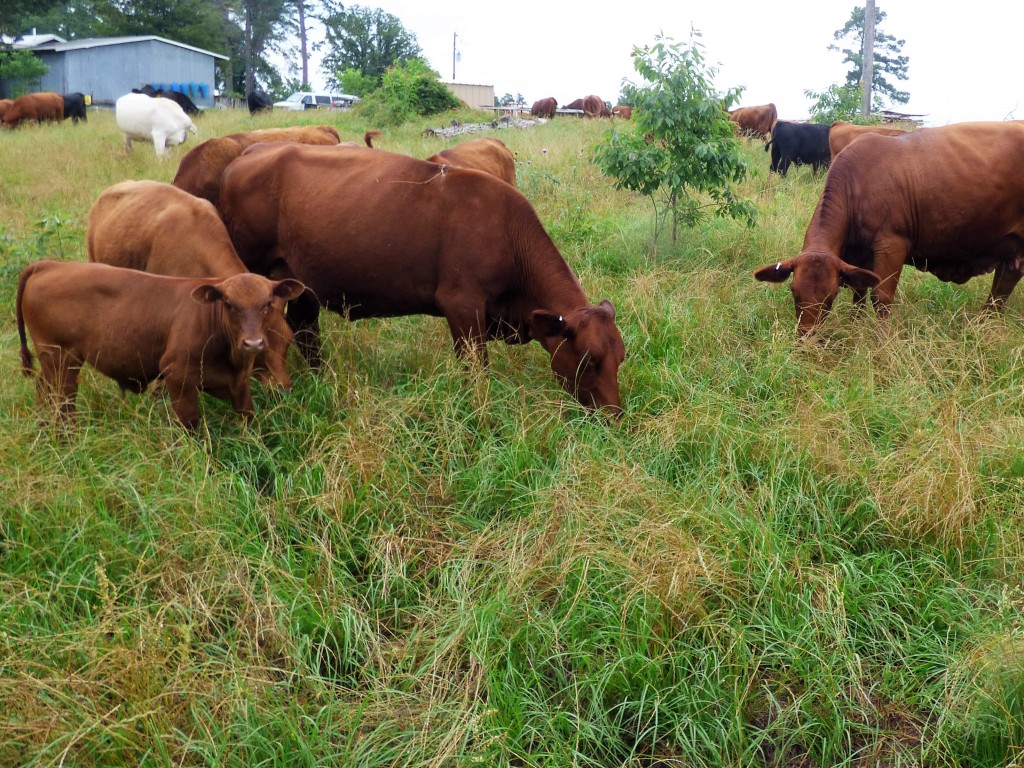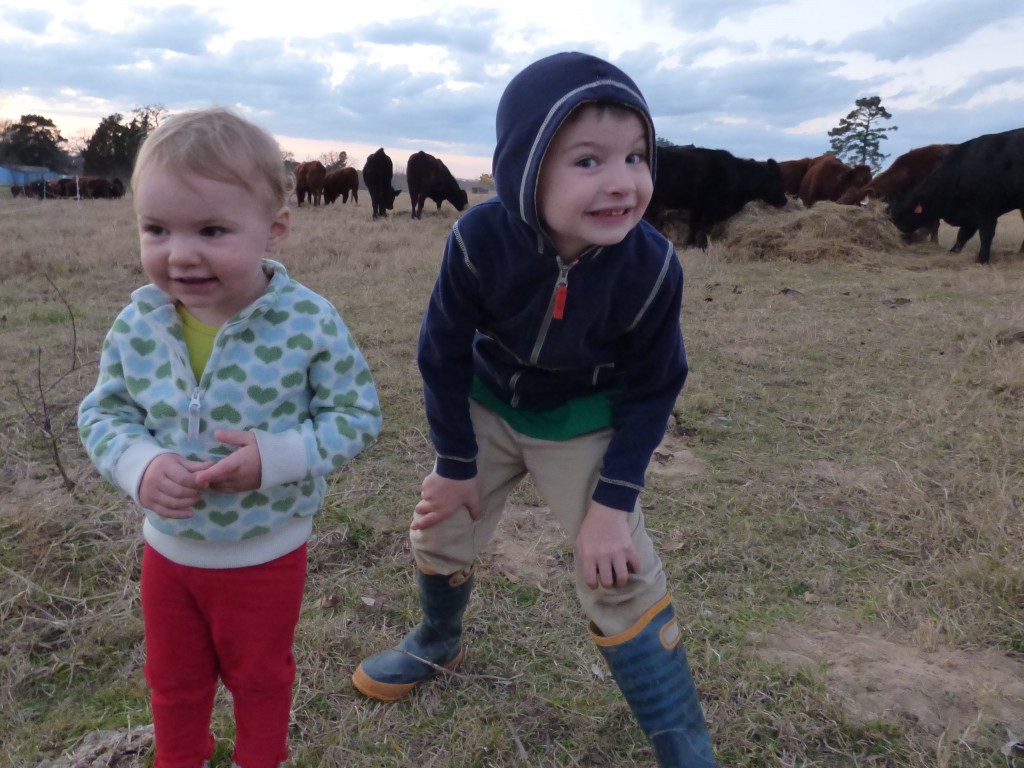1. The term “grass-fed” beef is no longer regulated as of January 2016.
This is a pretty complicated issue, but honestly, we don’t feel it’s entirely a bad thing. Why? Well, we were never terribly into government regulation of private industries. But when the standard was defined, there were still many loopholes and undefined parameters like antibiotic and hormone use, slaughter methods, and even feedlot use. You might have been buying beef that was fed grass a little grass throughout the finishing stage, but maybe the cows all had estrogen implants in their ears! The regulated term instilled a false consumer confidence because it didn’t cover all the bases.
Now, without official definition of the term “grass-fed” at the store, things have the potential to be worse because now the individual beef producers get to define what “grass-fed” means themselves, and all the government agency does is conduct auditing service. This basically means that the companies can’t cheat on their own self-established standards…
So what should you do?
We have always felt that rather than relying on government agencies to secure the moral outpouring of an industry, it is best to know your farmer and see your farm so you can know for sure whether things are what you think they are. Since when was it a bad thing to learn a little about the food you put in your body? You’re smart. Then you can decide for yourself whether the food you work hard to pay for meets YOUR standards. So ask the person who actually raised the animal what it was fed and what drugs it was given. Shake the hand that feeds you!

2. Many private “Grass-fed” standards allow not-so-grassy supplements.
That’s right. Not all “grass-fed” cows eat just grass. This is a complicated issue because of course there is always the possibility of extenuating circumstances, especially when it comes to livestock. We ourselves have experienced times of flooding, drought, and even wildfires! A good farmer will do what he needs to in order to take care of his animals. If the cows are starving, by golly, feed ‘em some grain, if there’s nothing else. But we at Shady Grove Ranch feel that we would need to disclose that to our customers, should that ever happen (and it hasn’t). We’re into the integrity of this–we want you to get what you think you’re getting. There’s that “shake the hand” idea again…
But if what you think you’re getting is a bunch of cows daintily nibbling a St. Augustine lawn trimmed to 2 ½ inches, well… your mental image of “grass-fed beef” may need a little tweaking. Technically speaking, grass is just one type of natural forage food for cows. There may also be herbs, legumes, brassicas, etc. Our cows even eat trees and brambles when they feel like it! But we feel that things like soy hulls, canola meal, and beet pulp is stepping just a little too far over the line. And yet many of these things are allowed by most big-name grass-fed standards, private or otherwise.
Why do they allow that?
I’m sure there’s no single answer. I would hope that most of the time it’s a stop-gap solution to our nation’s depleted soils or unfortunate weather anomalies. But the truth is that consumers are waking up to the need for better quality meats, and more and more often, they are choosing not to buy conventional meat.
So, naturally, the big food corporations are jumping on the grass-fed bandwagon, too. Perhaps these “approved supplements” are a way for them to produce beef quickly and cheaply without taking the time and effort to improve pastures. Or perhaps along the same line, newly established “grass-fed” herds are comprised of cows not well-adapted to grass-finishing, and additional supplementation is needed to get profitable yields. But should soy hulls and canola meal be on the menu, especially considering that almost all of the soy and canola grown in the US is genetically modified? You decide if GMO beet pulp fits your expectations for the top-dollar beef labeled “grass-fed.”
We feel that this is an integrity issue, most easily solved by encouraging you, the consumer, to be in touch with us, the farmer. I can tell you that we have most certainly never fed soy hulls and canola meal to our cows. If for some crazy reason we ever had to do it, we’d let you know! But chances are, we’d put the cows in the freezer before we bought that stuff for them! There’s more than one way to … feed a cow? 🙂

3. Grass-fed does not equal chemical-free.
You might not think there could be all that many chemicals in use in cattle production, but unfortunately, like most other industries, there are always clever new ways of avoiding natural production methods… And if you hadn’t already guessed, the “grass-fed” label doesn’t specifically prohibit any of those.
If you spot a package of “grass-fed” beef at your local supermarket, yes, the cows may have been eating grass (and as we’ve already pointed out, perhaps a few other not-so-grassy things). But there’s no guarantee that they haven’t also been receiving regular doses of chemical dewormers, vaccinations, antibiotics, and maybe even growth-stimulating hormones! Most of the issues requiring these drugs could be solved by simply rotating cows across pasture and managing the land well, using sustainable principles. But rotational production practices take more time and more man-hours. But isn’t it worth it, considering this is the precious fuel we’re putting into our bodies?
Let’s look past the labels.
If you’ve ever bought our beef, you probably noticed that it doesn’t have a single claim on the label. Why? Well, claims are expensive and time-consuming to develop, and as I’ve pointed out, none of the standardized claims is really all-inclusive as far as how we really manage our cows.
Yes, they’re grass-fed, yes, they’re hormone-free, no, they’re not fed soy or canola or anything else that looks like grain or is genetically-modified. They really are on growing, thriving pasture, and if the season causes the growing and thriving of the natural, grassy-looking vegetation to slow down, we feed them stored grass and forage–hay.
The beef tastes good, not because the cows are allowed to gorge themselves on corn, but because we make sure they have plenty of palatable pasture so they can graze to their rumen’s content and still have some grass left over so they don’t have to wander or compete to satisfy their hunger. When harvest time arrives, we choose animals for slaughter based on their appearance, not based on the calendar. If they’re not fat enough, we wait longer.
The cows don’t get diseases because we “breed the best and eat the rest,” meaning we choose the hardiest cows to re-breed, so our herd get healthier every year. And we never force them to live in their own manure. Even in winter, they are moved often to new, clean ground so they don’t have to eat or sleep in their excrement. We don’t prop up false health using drugs for the sake of a pedigree or for profit. Our big picture is self-sustained beef that promotes the eater’s health.
How do you put all that on a label? How do you teach busy but mindful customers what to look for in a beef source?
We hope this little article has helped, and we hope you’ll pass it on to someone you love. We love what we do and we want you to be part of it in your knowledge and in your enjoyment, and even in your experience, which is why we offer free farm tours throughout the year. Our next one will be some time in September, so we hope you’ll join us. Until then, buy really-real grass-fed beef from a farm you can trust!

As a homeschool mom, I often ponder what’s wrong in today’s systems, and how do I figure out what is most important in raising my own children and nurturing my family.
When I was younger I used to post compelling little soundbites to social media about all sorts of things. Food, mostly. I guess it was because I was excited about all the things


Thank you for this article! I love your meat and eggs, and you have never ever given me a reason to worry about the quality of what you produce. I haven’t been able to schedule a farm tour, but I still want to–maybe in September. Thanks, as always, for all you do.
Thanks for the article. I love the products that you sell and I’m teaching my kids to choose right for their health. Many of my friends show me what they get at the store for less money specially those with “grass-fed” label. I’m for sure will re-send the article so they can learn more about it.
This is true. It is so important to choose the right foods. Thanks for sharing and caring!
Pingback: Is Organic Food Making Us Unhealthier? - Shady Grove RanchShady Grove Ranch
I’m hearing that they will soon be vaccinating livestock with the COVID-19 vaccines. This is a concern for me since I’m not vaccinated and have no intention of eating vaccinated meats. What can you tell me about this? First of all, I always assumed ‘organic’ also meant unvaccinated. But since that’s not true, I at least want to have the right to know if the meat I eat has had the COVID-19 vaccines in order to avoid that.
Hi Kaylyn,
Great and important question for any consumer to ask of their food supplier. We do not vaccinate any of our livestock at all and fully plan to continue with this management strategy by providing good nutrition and proper pasture rotation management to our livestock.
Organic most certainly does NOT mean not vaccinated. You can only know the meat you are eating is unvaccinated by developing a trust-based relationship directly with your farmer. Vaccine-free farms are very difficult to find.
https://www.ams.usda.gov/sites/default/files/media/Organic%20Livestock%20Requirements.pdf